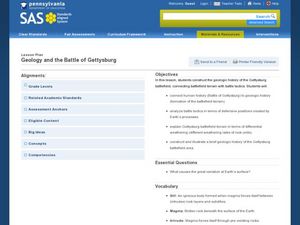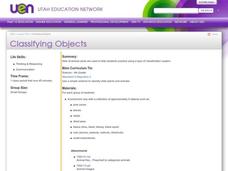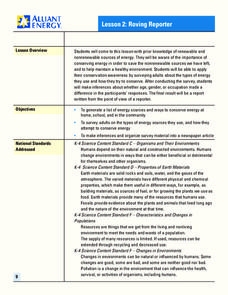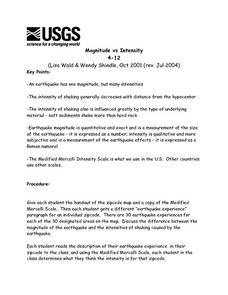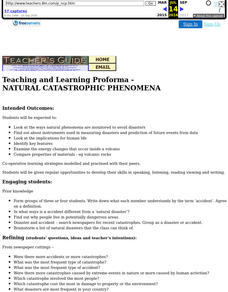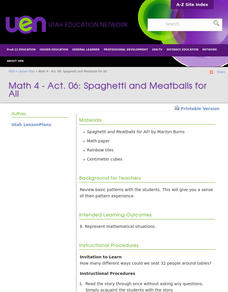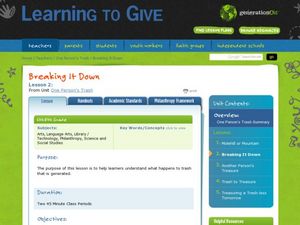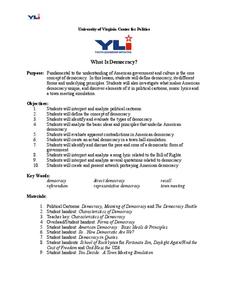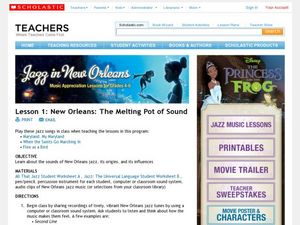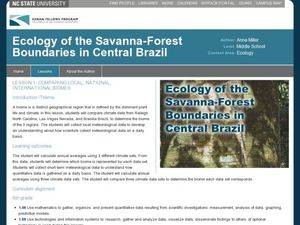Curated OER
Geology and the Battle of Gettysburg
Students create geologic maps of the Gettysburg battlefield. In this geologic skills lesson, students consider the variations of Earth's surfaces and explore strategies employed by the North and South in the Battle of Gettysburg to...
Curated OER
Give me Food!
Students study the food guide pyramid and use it to create their own eating program.In this health lesson plan students visit websites to calculate their BMR, activity level and weight then create a nutrition plan
Curated OER
Timbre: Identifying the Tone Color of the Saxophone
Students explore the concept of timbre. In this timbre activity, students experience timbres produced by saxophones in contemporary music. Students explore the science behind the music.
Curated OER
Classification is Sweet
Pupils classify, weight and organize items during this lesson plan. This lesson plan works great as or with an introduction of the Periodic Table of Elements.
Curated OER
Classifying Objects
Fourth graders work in small groups to sort and classify a variety of objects. They develop criteria for sorting and explain the characteristics they chose for classification. Groups record and share their classifications.
Curated OER
Porosity and Permeability
Students examine the concepts of porosity and permeability. They conduct experiments to determine the porosity and permeability of gravel, sand, and clay. After performing the experiments they collect and graph data, comparing the...
Curated OER
Roving Reporter
Students write a report about energy use. In this conservation lesson, students interview adults about their use of renewable and nonrenewable energy. Students synthesize this information and write a report from the point of view of a...
Curated OER
Bias Sampling
Students explore statistics by conducting a scientific study. In this data analysis lesson, students conduct a class poll about popular foods of their classmates. Students complete a worksheet and discuss how bias opinions affect the...
Curated OER
Our Special Planet Earth
Students explore what is special about our planet. They explore the various climates that are found on the planet Earth. Students create an advertisement to convince people why their favorite environment would be the best place to visit.
Curated OER
Magnitude vs Intensity
Students use a zipcode map to locate earthquake experiences based on the Modified Mercalli Scale. They discuss the difference of the magnitude of an earthquake compared to the intensity of the shaking it causes.
Curated OER
Transpiration
Students interactively explore the term transpiration. In this science/ecology lesson, students discuss what they would do if they were thirsty while conducting research in Brazil. Additionally, students write descriptive words to...
Curated OER
Natural Catastrophic Phenomena
Sixth graders examine the ways natural phenomena are monitored to avoid disasters. They find out about instruments used in measuring disasters and prediction of future events from data.
Curated OER
Math 4 - Act. 06: Spaghetti and Meatballs for All
Fourth graders use manipulatives to practice math patterns.
Curated OER
What's In A Name
Second graders read Chrysanthemum by Kevin Henkes. They then discuss where various names come from. They create a individualized biopoem and publish it on word processing software. Their poems are compiled into a class book and presented...
Curated OER
Mud Splat Craters
Students simulate crater formation using mud. In this earth science instructional activity, students identify the features of a crater. They explain how the force of impact affect the crater's appearance.
Alabama Learning Exchange
Planetary Cereal Project
Sixth graders decorate an empty cereal box with information and games showing their comprehension of factual information about an assigned planet. This is a nice, creative lesson about the solar system.
Curated OER
Geographical Features
Fourth graders explore geographical features through the creation and construction of an original island. In small groups they write a description and draw a blueprint of their island using a draw/paint computer program, and using...
Curated OER
Health: The Three Dimensions
Students examine the three dimensions of health, wealth, and happiness from both emotional and social perspectives. Among the week-long activities are discussions about good and poor habits, minimizing risks by proper planning and...
Curated OER
Mythology Spreadsheet
Students read a large variety of myths and discuss the characters and their attributes found in mythology. Then they identify and learn to set up an appropriate spreadsheet program. Students also enter the data to the class spreadsheet...
Curated OER
One Person's Trash: Breaking it down
Students research how trash is disposed of and make an edible landfill. In this trash lesson plan, students research proper trash disposal, and discuss how trash affects the community. Then they make an edible landfill.
Curated OER
What is Democracy?
Students examine civic duties. In this citizenship lesson, students play an online game that requires them to consider the needs of their community. Students campaign for the issue they choose in the game.
Curated OER
The Princess and the Frog
Young scholars study the sounds of New Orleans jazz, its origins, and its influences. In this jazz music lesson, students listen to various jazz songs and discuss the songs. Young scholars use the worksheet 'Jazz: the Universal Language'...
Curated OER
African Mask
Students research the importance of masks to the African culture. In this African mask activity, students design original masks using a variety of materials. Students use the template provided to create their masks.
Curated OER
Comparing Local, National, International Biomes
Students calculate averages of climate sets of data. In this ecology lesson, students analyze data to determine identity of a biome and collect meteorological data to understand process. Students also compare data sets.


